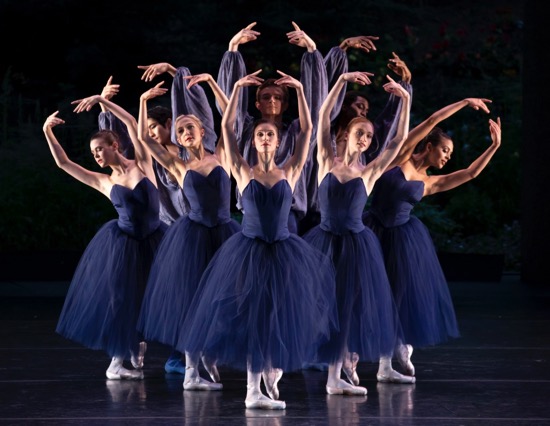
Do you ever wonder how choreographers choose their titles? After seeing James Whiteside’s New American Romance on the last day of American Ballet Theatre’s fall season at the former New York State Theater, I spent some time pondering that. The five women in its cast of eight wear dark blue, swirling, ankle-length tutus (provided by Primadonna). The music to which Whiteside set his ballet, Claude Debussy’s Suite Bergamesque, was composed around 1890, and its third section, “Claire de Lune,” is so famous that if you mention it to someone, that person may start humming its opening notes. Debussy was inspired by a poem of that name by Paul Verlaine, who died in 1896. It begins:
Your
soul is a chosen landscape
Where charming masquerades and dancers are promenading,
Playing the lute and dancing, and almost
Sad beneath their fantastic disguises.
If you rule out the lute and the fantastic disguises and don’t take “masquerades’ too literally, you have almost sad dancers and the soul as a landscape and. . . .
I will now stop playing around.
Pianist Jacek Mysinski plays the four movements of Debussy’s music, and Whiteside, a principal dancer in the company and a versatile choreographer, shifts aspects of classical ballet slightly and imaginatively to fit the accompaniment’s moods. Catherine Hurlin and Aran Bell, leading the rest of the cast in the first movement, gesture longingly toward each other. He shows off for her. Various of the other women (Isadora Loyola, Devon Teuscher, Katherine Williams, and Stephanie Williams) fly by. Hurlin, I scribbled in my notes, was “a woman you could mess with.”
All eight dancers figure in the last movement. Three of the women shake their shoulders to suit the staccato arpeggios of the music. All five of them scamper away. The three men have a moment to stand out. Whiteside manages all this with aplomb, although I have a few cavils. The choreography hints at emotions and social manners, but why must a man hoist a woman high when her bouffant skirt turns him into Mr. Tutu Head— especially if he’s going to put her down shortly? And I wonder, in a new and inventive ballet like this (it premiered at the Vail Festival last July), why dancers leaving the stage can’t convey that they have a reason for doing so, as well as a reason for reappearing.
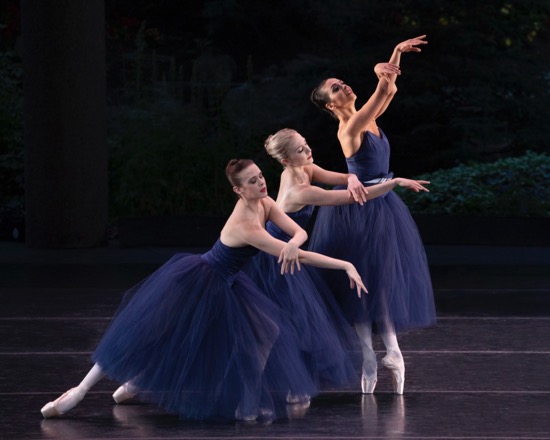
Whiteside’s second movement is a trio for K. Williams, backed by Loyola and S. Williams. They hold hands and strut on pointe, quite flirty, but also jump several times in a row. Nor are they afraid to sit on the floor. Brandon Stirling Baker’s lighting softens and darkens for the third movement, a duet for Teuscher and Joo Won Ahn that becomes a triangle when Calvin Royal III appears. That is, Ahn leaves the stage briefly, but reappears and kneels to clutch Teuscher’s legs. Once Royal gets going, the other two sit and watch him. Then Teuscher joins him and, finally, Ahn merges with the two of them.
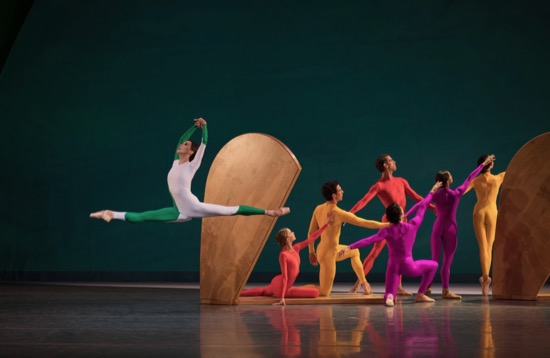
Jessica Lang’s Garden Blue, which premiered in New York last October is also set to nineteenth-century music: the first three movements of Antonin Dvořák’s Piano Trio No. 4 in E Minor, coincidentally created a year after Debussy’s suite. It is labeled a Dumky (plural of Dumka, derived from Duma, which refers to the songs of captive people—a parenthetical attribute that may not have figured in Lang’s thinking. The music is played by Robin Zeh (violin), Scott Ballantyne (cello), and Emily Wong (piano).
There’s another star in the ballet beside Hee Seo and three couples. It’s the set by visual artist Sarah Crowner, one of whose works, Sculpture Garden Blue, infuenced the title of Lang’s work and possibly some of its patterns. Crowner’s three wooden structures were inspired by the winged pod that encases the single seed of, say, a maple tree, enabling it to fly away before alighting. You could think of Seo as behaving like that seed. Wearing a green and white unitard that links her to some of Crowner’s paintings and to the related backdrop, she leaps along with the others—at times leading them, at times following. She attaches herself to one of the three pairs; at another time, the three men fly her to a new spot onstage.
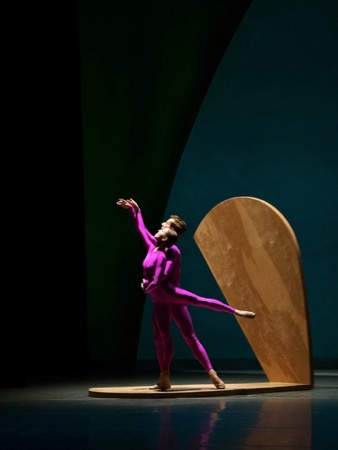
The couples in pungently colored unitards are Skylar Brandt and Blaine Hoven (magenta), Catherine Hurlin and Aran Bell (red), and Brittany DeGrofft and Thomas Forster (yellow). They tip, rotate, and rearrange two of the set pieces; the third, hanging overhead, slowly rotates at first, perhaps simulating a gentle wind. These wooden structures become islands for pairs to inhabit, or V’s over which a dancer arches his partner and rocks her gently, or a cradle in which Seo, barely visible, rests for a while. Nicole Pearce’s lighting warms or cools the atmosphere, while Dvořák’s music kindles the action with its allegro and vivace passages and soothes it with andante ones.
As I recall, no one leaves the stage (except maybe Seo). Often the others pose as a group, wait, and stare into the distance. But these are people,not just symbols of planting and growth. Partners help each other into various maneuvers; they rest, sleep, fit themselves together. Lang gives them all a chance to show their agency, their desires, their polish as dancers. And show these they do.
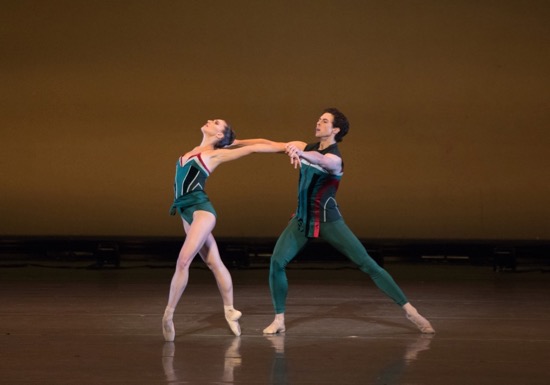
Gemma Bond’s A Time There Was premiered during this Fall season, and—as the final and most heavily populated work on the program—it was accompanied by a full orchestra, conducted by David LaMarche. The ballet is set to Benjamin Britten’s 1974 Suite on English Folk Tunes (A Time There Was) as well as the Fugue and Finale from his Variations on a Theme of Frank Bridge (1937). As the program explains,Britten was inspired by a 1928 poem by Thomas Hardy and used its opening words as his subtitle:
A time there was—as one may guess/And as, indeed, earth’s testimonies tell—/Before the birth of consciousness,/When all went well.
The Suite was Britten’s last work; he was unwell when he wrote it and died two years later. You can tell from the titles of its sections that some of the music will frisk and dart and other stroll sweetly and sadly: “The Bitter Withy,” for instance, or “Hunt the Squirrel.”
Bond, who danced in Britain’s Royal Ballet before joining ABT, has been a choreographer since 2010. A Time There Was is a very big ballet. Three principal couples, three slightly secondary ones, and three third-string women dance in and out of four short sections framed by a full cast opening (“Cakes and Ale”) and the Fugue and Finale brings in everyone.
Perhaps because the work is set to so many diverse musical sections, you can find yourself gasping to follow it. You occasionally want to call out, “stop a minute!” Or “put her down!” Or “just walk around for a few seconds!” Dancers come and go or pass by, but there’s no over-riding theme that suggests, say, games being played or, on the other hand, formal offerings being presented and disappearing. Nevertheless, there are many pleasures to be had in watching the ballet, including a great deal of excellent dancing by a cast garbed by Sylvie Rood in costumes that, to my mind, suggest fanciful armor.
You can relish Cassandra Trenary and Cory Stearns assisted by three busy women in wine-colored outfits (Lauren Bonfiglio, Hannah Marshall, and Sierra Armstrong). Or Zimmy Coker and Gabe Stone Shayer leaving their colleagues Courtney Shealy and Carlos Gonzalez, together with whom they backed up Katherine Williams and Tyler Maloney in “Hankin Booby” (don’t ask), to join Trenary in “Hunt the Squirrel.” You can sympathize with Stearns alone in Serena Wong’s dimming light, stretching mournfully and silkily into his moves (“Lord Melbourne”). That’s before Thomas Forster, drooping, joins Carlos Gonzalez, Maloney, and Shayer. All four of them have fallen to the floor when Devon Teuscher arrives and Forster can unite with her. Stearns reappears, as I recall, to lead them all off the stage.
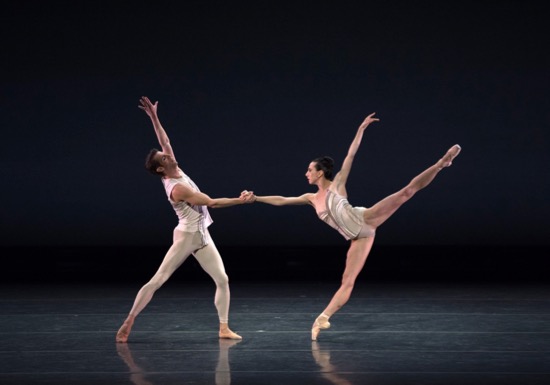
Things calm down a little for the “Fugue and Finale,” in which Isabella Boylston and James Whiteside are watched and succeeded by seven of the women. In their pale outfits, they can make you imagine a wedding of like-minded souls. Maybe it’s the dancers’ awareness of one another that makes this section seem the strongest and clearest.
I was too late in making my request for a ticket to the evening that celebrated Herman Cornejo’s twenty years in ABT. So I didn’t see this magnificent and profoundly focused performer dance with his sister Erica or perform Balanchine’s Apollo or see him honored by Twyla Tharp as the Host in her premiere, A Gathering of Ghosts. I could only watch him in a rehearsal film clip or a slow-motion film of him dancing in the extraordinary costume that Norma Kamali designed for Tharp’s work, or catching Tharp as she leapt into his arms during the curtain call. In my heart, I congratulate Cornejo and wish him many more dancing years.
.

ABT’s press ticket policy is like a huge grinding machine that cuts you off at the knees, if you miss the request deadline; that needs fixing! I saw the same show on the 23rd. I’m always proud of myself when we agree. My take is at http://www.solomons-says.com. As usual, you know so much more about what you’ve seen than anyone has a right to! xoxo
Thank you for this support. I love it when we agree! xoxo